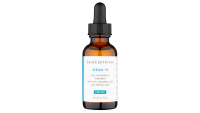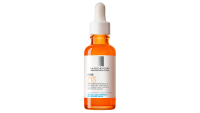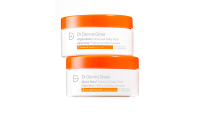How to get rid of acne scars, according to the experts
Determination and the right treatment is how to get rid of acne scars, say these dermatologists

The concern around breakouts and how to get rid of acne scars - including menopausal acne scars - has escalated during social distancing.
If you've beaten acne – congratulations, we know what a hard-won battle that is. We also understand that it can feel like a hollow victory if you are still faced with visible reminders in the form of pitted scars or red/dark pigmented patches.
On the upside, with time and the right products in your skincare arsenal, it is possible to reduce their appearance. First, however, it's important to understand what acne scars are, as they differ from the scars left by your average cut. Acne scars are small depressions in the skin – some are ice pick, others are rolling or boxcar scars.
"Acne can cause trauma to the skin and as acne lesions heal, the collagen that is produced may be deficient," says Dr Alexis Granite, Consultant Dermatologist at Mallucci London. "Atrophic scars are flat depressions in the skin. Boxcar scars are broad, box-like depressions with sharply defined borders. Ice pick scars are small, narrow indentations that are deeper than boxcar scars. While rolling scars have sloping edges and may cause the skin to look wavy and uneven."
And then there are acne marks, which are smooth red or dark marks left on the site of a spot long after it's gone. Darker skin tones are more prone to pigmentation on the site of a spot because more melanin is produced in the skin to defend and protect against trauma.
Ahead are four expert tips for improving the look of acne scars and marks at home, including how to combat pigmentation.
Vitamin C
Often when you even out the color of a scar, the texture no longer seems to be such a deal-breaker. When it comes to brightening and fading dark hyperpigmentation, look no further than vitamin C, which is packed with protective antioxidants while brightening it to reduce the appearance of dark spots.
Sign up to our free daily email for the latest royal and entertainment news, interesting opinion, expert advice on styling and beauty trends, and no-nonsense guides to the health and wellness questions you want answered.
"Vitamin C works to fade all types of pigmentation so is an excellent choice when looking to fade post-inflammatory marks. I would recommend a concentration of 10% or higher," says Granite.
Additionally, when carefully and slowly incorporated into your skincare routine, the best retinol cream, a derivative of vitamin A, can help treat discoloration by boosting cell turnover and stimulating collagen production. Use vitamin C by day and vitamin A overnight and "always apply daily sun protection," warns Granite.
Alpha hydroxy acids (AHAs)
According to New York dermatologist Dr Dennis Gross, acids are a great way to fade post-inflammatory hyperpigmentation, as "AHAs like lactic acid work to remove dead pigmented cells from the skin’s surface by gently loosening the bonds that hold these dead skin cells together."
Other AHAs go beyond just exfoliation so it's worth considering adding these to your routine. "Kojic acid, for example, actually prevents melanin production at the source, deep within the skin," says Gross.
But, above all, he favors a product that incorporates vitamin C alongside AHAs like lactic acid and arbutin. "L-ascorbic acid, or vitamin C in its purest form, reduces melanin production, slows melanin transfer, and calms inflammation. This cocktail will ensure that you target existing pigmentation on multiple levels while preventing future discoloration."
Another strategy is doing regular mild acid peels at home.
Gross' pre-soaked, two-stage Alpha Beta Universal Daily Peel fits the bill for ease. "Step one is the alpha and beta hydroxy acids," he explains. "The pad combines multiple acids at lower concentrations so you are getting all of the benefits of each without the irritation. The second step is the neutralizer, which is also loaded with tons of anti-aging ingredients, including retinol, and soothing ingredients."
Microneedling
With collagen production being cited as the main aim for improving the depth and texture of acne scars, microneedling comes into its own.
"Microneedling is a non-invasive treatment that creates microscopic damage to the skin using a handheld device and very short, very fine needles," explains Gross. "By puncturing the outer layers of the skin, the goal is to kickstart the skin's healing mechanisms and produce new collagen for smoother, more rejuvenated skin."
Numbing cream is used during the treatment so you're unlikely to feel anything except a slight scratching - a bit like a cat's tongue. But be warned skin looks extremely sunburnt for a day or two, so it's worth booking in at the end of the week to allow adequate time to recover over the weekend.
Professional in-office treatments
The unfortunate truth is that once a spot has scarred, professional in-office treatments will offer maximum results in improving its appearance.
"For atrophic scars, collagen needs to be stimulated or remodelled in order to improve their appearance," says Granite. "Lasers such as Fraxel and CO2 can be very effective.” She adds that TCA peels and hyaluronic acid fillers can also help but that often a combination treatment approach works best.
Fiona Embleton is an award-winning beauty director with over 15 years of industry experience and has held staff positions on Stylist, Marie Claire, Cosmopolitan and Glamour. She covers all aspects of the beauty industry and specialises in long-read features, fragrance and skincare.


